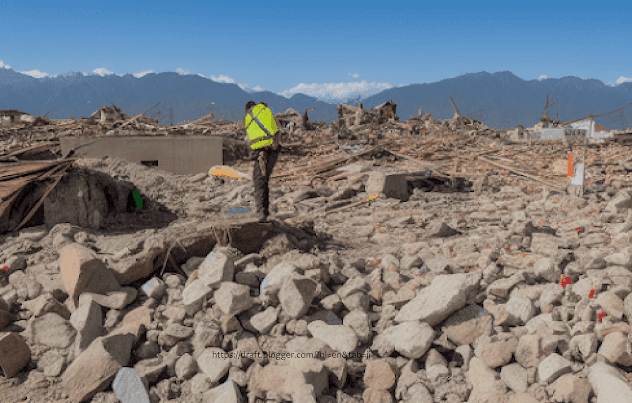"Exploring the Bali Earthquake of 2023:
Causes, Impact, and Recovery Efforts"
Natural disasters have the power to send shockwaves through communities, leaving devastation in their wake.
One such event, the Bali earthquake of 2023, has recently shaken the picturesque Indonesian island.
This article delves into the causes behind the earthquake, its impact on the region, ongoing recovery efforts,
and the resilience of the local population.
Table of Content
The Bali Earthquake of 2023
Magnitude and Epicenter
On the fateful day of August 28, 2023, the tranquil Bali Sea was jolted by a powerful earthquake
with a magnitude of 7.1. The earthquake's epicenter was pinpointed in the vicinity of Bali, Indonesia,
sending shockwaves across the island and its neighboring regions. The tremors were strong enough
to be felt as far away as Java and Lombok.
Seismic Activity in the Region
Indonesia rests on the Pacific "Ring of Fire," an area characterized by intense tectonic activity and frequent
earthquakes. The country is situated at the convergence of several major tectonic plates, making it highly
susceptible to seismic disturbances. The Bali earthquake of 2023 was a stark reminder of the geological forces at
play in this region.
Impact on Bali and Its Residents
Infrastructure Damage
The earthquake inflicted significant damage to Bali's infrastructure. Buildings, roads, and bridges were
either reduced to rubble or left structurally compromised. The iconic cultural landmarks that drew tourists
from around the world were not spared either. The destruction of vital infrastructure posed an immediate
challenge to the island's recovery.
Human Casualties and Injuries
Tragically, the earthquake led to loss of life and numerous injuries. Many residents and visitors found
themselves caught in the chaos, and emergency services were stretched to their limits. The aftermath of the
quake left families grieving and communities in shock, emphasizing the need for swift and effective response
measures.
Immediate Response and Relief Measures
Government Initiatives
The Indonesian government swiftly activated disaster response protocols. Evacuation centers were set up to
provide shelter to those displaced by the earthquake. Medical teams were dispatched to offer aid to the injured,
and search and rescue operations were initiated to locate survivors trapped under debris.
International Aid and Support
The international community rallied behind Bali, offering aid and support in various forms.
Humanitarian organizations, neighboring countries, and global relief agencies sent supplies, medical teams,
and financial assistance. The collaborative efforts showcased the spirit of solidarity in times of crisis.
Challenges in the Aftermath
Displacement and Homelessness
The earthquake forced many residents to flee their homes, seeking refuge in makeshift shelters.
The challenge of providing temporary housing and addressing the immediate needs of the displaced population
added to the complexity of the recovery process.
Economic Setbacks
Bali's economy heavily relies on tourism, which was severely impacted by the earthquake.
The destruction of tourist facilities and the negative media coverage led to a sharp decline in visitor numbers.
The loss of revenue posed economic challenges for both individuals and businesses.
Rebuilding Bali: The Road to Recovery
Reconstruction of Infrastructure
The path to recovery involves the arduous task of rebuilding infrastructure. Construction crews and volunteers
worked tirelessly to restore homes, public buildings, and tourist attractions. The process demanded meticulous
planning to ensure the structures would be more resilient to future earthquakes.
Psychological Rehabilitation
Recovery isn't just physical; emotional scars also need healing. Trauma counseling and support
services were offered to those affected by the earthquake. Communities came together to provide a sense of
belonging and mutual aid, fostering emotional recovery.
Resilience of the Balinese People
Cultural and Community Strength
The Balinese people drew strength from their rich cultural heritage and strong sense of community.
Traditional practices and rituals played a role in uniting individuals during the difficult times, showcasing the
power of culture as a source of resilience.
Adapting to Natural Disasters
Living in a region prone to earthquakes, the Balinese have developed a keen awareness of disaster
preparedness. Schools and organizations conducted drills to educate people about safety measures.
The earthquake served as a reminder of the importance of remaining vigilant.
Lessons Learned and Future Preparedness
Improving Early Warning Systems
The earthquake highlighted the need for enhanced early warning systems. Investments in technology that can
detect seismic activity and issue timely alerts could save lives in future disasters.
Public Awareness and Education
Education plays a crucial role in disaster preparedness. By educating the public about earthquake risks and
safety measures, communities can be better equipped to respond effectively and reduce the impact of future
earthquakes.
Conclusion
The Bali earthquake of 2023 shook more than just the ground—it tested the resilience of a community,
revealed vulnerabilities in infrastructure, and demonstrated the strength of international solidarity.
As Bali embarks on its journey of recovery and reconstruction, the lessons learned from this disaster will
serve as a foundation for building a more prepared and resilient future.
FAQs
Q: How often does Indonesia experience earthquakes?
A: Indonesia experiences frequent earthquakes due to its location on the Pacific Ring
of Fire, a seismically active area.
Q: What is the Pacific Ring of Fire?
A: The Pacific Ring of Fire is a horseshoe-shaped region characterized by high tectonic
activity, including earthquakes and volcanic eruptions.
Q: How did the international community assist Bali after the earthquake?
A: The international community provided aid through humanitarian organizations,
relief agencies, and neighboring countries, offering supplies, medical teams, and
financial support.
Q: What role does cultural strength play in recovery?
A: Cultural strength fosters a sense of unity and support during challenging times,
helping communities recover emotionally and rebuild together.
Q: What can individuals do to prepare for earthquakes?
A: Individuals can educate themselves about earthquake risks, create emergency kits,
and have a family disaster plan in place to stay prepared.












Post a Comment
Post a Comment